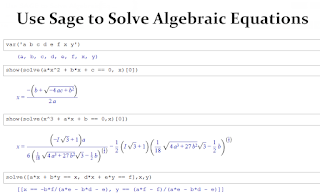Algebra Chapter 1 Section 3: Solving Equations
In this third section of Chapter 1, I will cover the basics of equation solving. I've already touched on this in Physics, and will get to in in Chemistry; this is vital for all of math and science, including Economics.
Equivalent Forms
One of the most vital statements in Algebra is that two equations which have the same solutions are equations. In all future endeavors, both science and in math, we look to solve for the variable that is unknown, and the final form of that equation doesn't look anything like the initial equation, but is in an equivalent form, so has all of the same solutions as the initial equations. For any real numbers a, b, c, and d, $a+c=b+c$ is equivalent to $a=b$ and $a=b$ is equivalent to $a \times d=b \times d$. What we can do from here is say that $a+c=b+c$ is equivalent to $a \times d=b \times d$.
For example, in the expression $5x^2 +2x +3-2x^2 -1$, the $5x^2$ and $-2x^2$ are like terms since they both have a variable which are identical to one another ($x^2$). The terms $3$ and $-1$ are also like terms since they both "have a variable which are identical to one another"; in this case that means they both have no variables.
This concept also applies to constants which don't have any number associated with them yet. In the expression 9a+2b-3ab+1, where a and b are general constants (constants of which we don't know the value), there are no like terms since there are no terms with exactly the same "general constant representations". After all, we don't know that $a=b$, so we cannot say that the first two terms can be combined. We also don't know that $a \neq b$. Since we don't know whether or not a and b are equal, we cannot combine those terms.
That's the end of this section. If you have any questions, please leave them is the comments. Like and share this post if you found it helpful. And until next time, stay curious.
To help get this lecture series come out with higher frequency, please donate to The Science of Life. This helps keep the information current and allows me to dedicate more time to this project instead of obtaining money through external means.
←Previous Next→
Like Terms
In any equation, a "term" is any constant, variable, product of any number of constants and/or variables, or the quotient of any number of constants and/or variables. When two or more terms have variable components which are perfectly identical, those terms are said to be similar (or like) terms. Often times, it is prudent to combine these terms.For example, in the expression $5x^2 +2x +3-2x^2 -1$, the $5x^2$ and $-2x^2$ are like terms since they both have a variable which are identical to one another ($x^2$). The terms $3$ and $-1$ are also like terms since they both "have a variable which are identical to one another"; in this case that means they both have no variables.
This concept also applies to constants which don't have any number associated with them yet. In the expression 9a+2b-3ab+1, where a and b are general constants (constants of which we don't know the value), there are no like terms since there are no terms with exactly the same "general constant representations". After all, we don't know that $a=b$, so we cannot say that the first two terms can be combined. We also don't know that $a \neq b$. Since we don't know whether or not a and b are equal, we cannot combine those terms.
Linear Equations
A linear equation is an equation where all variables have exponents of 1. Typical linear equations seen in this lecture series will be of one-dimension, so that the equation will only have one variable (typically x) where the exponent will always be 1. Examples of this are $y=x$, $y=-5x+2$, and $y+10=42x$. An identity is anything that is true all the time. A contradiction is an equation which is "true" none of the time. A conditional equation is an equation which is true under certain circumstances. Sets are merely collections of numbers grouped together. The jersey numbers of your favorite sports club are a good representation of a set; all of those jersey numbers belong on one team while interacting with one another, but never combining into one player. An empty set is a set with no numbers in it, kind of like if somehow a team had no players.Solving Equations
The point of solving an equation is to get to the point of having an unknown in an equation with only one unknown alone on one side of the equals sign and everything else on the other side of the equation. A good example is trying to find the radius of Earth from the gravitational force equation $F_{G}=G \times \frac{m_{1} \times m_{2}}{r^{2}}$. What needs to be done here is to get the distance alone on one side of the equals side and everything else on the other side. First things first, we multiplying both sides by the square of the radius, so that on the right side, the $r^{2}$'s cancel and on the left, we have $F_g \times r^{2}$. Then we divide both sides by $F_g$ on both sides to get $r^{2}$ on the left and $G \times \frac{m_{1} \times m_{2}}{F_g}$ on the right. Now, we take the square root on both sides to get $r=\sqrt{G \times \frac{m_{1} \times m_{2}}{F_g}}$.That's the end of this section. If you have any questions, please leave them is the comments. Like and share this post if you found it helpful. And until next time, stay curious.
To help get this lecture series come out with higher frequency, please donate to The Science of Life. This helps keep the information current and allows me to dedicate more time to this project instead of obtaining money through external means.
←Previous Next→


Comments
Post a Comment